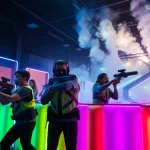
What is Laser Tag?
Laser tag is an exhilarating game that combines strategy, technology, and a lot of fun, making it one of the most popular recreational activities across the globe. Players engage in simulated combat while harnessing infrared-emitting light guns to tag opponents and score points. As the world becomes increasingly digitized, laser tag has emerged as a thrilling alternative to traditional gameplay, where players can engage in a real-life experience that offers both physical engagement and exciting competition.
Understanding the Basics of Laser Tag
At its core, laser tag is designed for individuals or teams to outmaneuver and outscore their opponents within a defined playing area. Participants wear electronic vests that detect hits from an opponent’s laser gun, adding a layer of excitement and competitiveness to the gameplay. The objective is straightforward: tag as many opponents as possible while avoiding being tagged yourself.
This sport appeals not only to children but also to teenagers and adults, making it an adaptable choice for birthday parties, corporate events, or simply a night out with friends. The gameplay’s strategic nature requires players to utilize teamwork, planning, and stealth, mirroring tactical military operations in a kid-friendly format.
The Equipment Used in Laser Tag
Laser tag equipment typically includes two main components: the laser gun (or phaser) and a vest worn by each player. The laser gun emits infrared light that acts as the ammunition in the game. Modern laser guns often come equipped with features such as scopes, multiple firing modes, and sound effects to enhance the experience.
Players wear a vest or a harness fitted with sensors that detect when they are hit by an opponent’s infrared beam. Some advanced systems allow for customizable vests with various features, such as audio cues or feedback mechanisms that provide real-time data about the players’ performance. Depending on the venue, there may also be themed accessories that can elevate the game, immersing players further into the experience.
The Rules and Objectives of the Game
While specific rules may vary between venues, most laser tag games operate under a set of universal guidelines. For each match, players are typically divided into teams with designated starting zones. The main rules of the game include:
- Players must remain within the defined arena boundaries.
- The game often has a time limit, usually ranging from 15 to 30 minutes.
- Players can be ‘out’ for a certain period after being tagged, depending on the rules set by the arena.
- Scoring often depends on how many opponents a player tags and may have point multipliers for specific actions.
Ultimately, the aim is to deplete the opposing team’s score while maximizing your team’s performance, making teamwork and tactical planning essential elements for victory.
The Benefits of Playing Laser Tag
Engaging in laser tag is not just about competition and fun; it also offers several key benefits that extend beyond the game itself. Whether you’re a player gearing up for your first match or a seasoned pro, understanding these advantages can enhance your experience and appreciation for this unique sport.
Health Benefits of Laser Tag
Participating in laser tag provides significant physical benefits. Despite not being an Olympic sport, a typical game can be quite the workout. Players engage in running, dodging, and strategic movements which contribute to cardiovascular health.
Some of the notable health benefits include:
- Cardiovascular Fitness: The fast-paced environment promotes increased heart rates and improves overall endurance.
- Improved Coordination: Players must navigate through obstacles and adjust to their teammates’ movements, honing their eye-hand coordination and agility.
- Stress Relief: The adrenaline rush of competition, combined with physical activity, acts as a natural stress reliever, providing a fun outlet for frustration.
- Social Interaction: As a communal game, laser tag encourages interactions, fostering friendships and teamwork.
Socializing and Teamwork Skills Development
Laser tag is among the few activities that excel at building social skills regardless of age. Whether children are learning to communicate effectively or adults are enhancing their leadership skills, the collaborative elements of the game cannot be understated.
The benefits in this domain include:
- Enhanced Communication: Players need to discuss strategies and relay information quickly, which fosters essential teamwork communication.
- Conflict Resolution: With competitive elements in play, players develop the ability to navigate stress and make quick decisions, valuable skills applicable in everyday life.
- Leadership Opportunities: Designating teams and planning strategies allow participants to take on leadership roles, building confidence.
Fun Factors: Why People Love Laser Tag
The primary reason people flock to laser tag is undoubtedly the thrill of the game itself. It is an excellent way to combine gaming and athleticism, offering a unique and immersive experience that captures the imagination. There are numerous reasons behind its popularity:
- The Element of Surprise: The unpredictability of the game makes each match unique, maintaining high levels of excitement and engagement.
- Themed Arenas: Many arenas offer custom themes and settings that add an extra layer of adventure to the experience, such as sci-fi or military environments.
- All Ages Welcome: The adaptable nature of the game means it can be tailored to suit various age groups and skill levels, making it a versatile choice for mixed-age gatherings.
- Social Experience: It serves as an attractive alternative to more traditional party games, offering an interactive platform for bonding.
Types of Laser Tag Experiences
With the evolution of laser tag, various types of experiences are available to cater to different preferences and atmospheres. Exploring these variants can help players select the best fit for their preferences or events.
Indoor vs Outdoor Laser Tag
Laser tag can take place in both indoor and outdoor settings, each offering its unique challenges and vibes. Indoor laser tag often features multi-level arenas with various obstacles, dim lighting, and thematic soundscapes. This setting allows for controlled environments, making it accessible year-round regardless of weather.
In contrast, outdoor laser tag expands the playing field and incorporates natural elements into gameplay. Players may navigate through parks or open fields, leading to exhilarating experiences full of strategy and tactical movement under open skies. However, variations in terrain can present additional challenges, such as managing uneven ground or obstacles.
Certain Themed Environments for Laser Tag
Thematically designed arenas have gained popularity, creating an immersive environment tailored to enhance gameplay experience. Common themes include:
- Space Adventure: Utilizing dark lighting and sci-fi elements, players navigate through a spaceship setting.
- Zombie Apocalypse: Challenges players to survive amid a horror-themed environment filled with special effects.
- Military Warfare: Mimicking combat scenarios with realistic props and setups, adding an aspect of realism to the game.
These themed environments increase immersion and engagement, allowing players to escape reality and enter a world of imagination.
Virtual Reality Laser Tag
With advancements in technology, virtual reality (VR) laser tag has surfaced as a trend, taking the typical experience to the next level. Virtual reality combines physical gameplay with immersive digital experiences, allowing players to combat in fully rendered environments. VR laser tag typically requires headsets and specialized equipment that track each player’s movements throughout digital landscapes.
This variation gives players the ability to interact with digital elements dynamically, fostering a new kind of engagement that blends traditional gaming with cutting-edge technology.
How to Organize a Laser Tag Event
Whether you are planning a birthday party, corporate event, or just want to gather friends for a fun outing, organizing a laser tag event is straightforward if you follow key steps. Here’s how to ensure that your event is successful and enjoyable for everyone involved.
Choosing the Right Venue
The first step in organizing a laser tag event is selecting an appropriate venue. Look for locations that:
- Have a suitable size for the number of participants.
- Provide the necessary equipment, such as guns and vests.
- Offer a safe playing environment with trained staff.
- Can accommodate the age range of your guests.
Researching reviews and testimonials from previous customers can help ensure that the venue is reputable and provides a quality experience. Some venues offer packages that include food, drinks, or decorations, which can simplify logistics.
Planning the Event Logistics
Once you have a venue in mind, plan the logistics of your event. This involves deciding on:
- The date and time that works for the majority of guests.
- The duration of the game sessions based on guest preferences.
- Safety protocols and rules to share with guests before playing.
Creating a timeline of events is essential for maintaining organization and ensuring that everything runs smoothly. Distribute this information to guests ahead of time so that they know what to expect.
Creating the Perfect Competitive Environment
To elevate the competitive spirit of your laser tag event, consider implementing some elements of gamification:
- Establish teams with balanced skill levels to ensure fair play.
- Create a leaderboard to track individual or team scores, incentivizing friendly competition.
- Incorporate bonus rounds or challenges that grant extra points or rewards.
Providing small prizes for winners or recognition for unique achievements can create an engaging atmosphere and motivate players to invest themselves in the game.
Tips for Winning at Laser Tag
Success in laser tag is not just a matter of luck; strategy and teamwork play crucial roles in determining who comes out on top. Here are some practical tips to enhance your chances of winning, whether you’re a newbie or a seasoned player.
Strategies for Beginners
If you’re new to laser tag, the focus should be on learning the mechanics and getting accustomed to the environment. Start with these strategies:
- Stay Mobile: Constant movement makes you a harder target and allows you to scout areas for enemies.
- Use Your Equipment Wisely: Familiarize yourself with how your gun operates and the best practices for aiming.
- Communicate with Your Team: Clear communication is essential. Let teammates know your location and if you see an opponent.
Advanced Techniques for Experienced Players
For players who have already grasped the basics, consider employing these advanced techniques:
- Flanking Tactics: If possible, maneuver around the opponents to perform a surprise attack. Create diversions with other team members to do this successfully.
- Cover and Concealment: Use the environment to your advantage by hiding behind obstacles and plotting your movements strategically.
- Observation: Pay attention to the patterns of your opponents and adapt your strategies accordingly. Knowing when to attack and when to retreat is vital.
Team Coordination and Communication
The best laser tag players understand that collaboration is key to victory. Be sure to
- Designate Roles: Assign roles based on individual strengths. Some players may excel in stealth while others might thrive in aggressiveness.
- Share Responsibilities: Approach the game as a unit, ensuring that no one is left isolated. Cooperative tactics can overwhelm opponents.
- Feedback and Adaptation: If a particular strategy isn’t working, communicate this to the team to reassess and pivot your approach.
With solid teamwork, clear communication, and strategic execution, you’ll increase the odds of your team emerging victorious.





